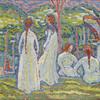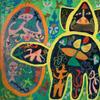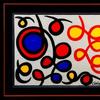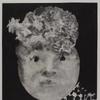Long-Lost Artworks from 1893 World's Fair Found in Chicago Storage
- CHICAGO, Illinois
- /
- August 27, 2015
Mayor Rahm Emanuel and Chicago Park District General Superintendent and CEO Michael Kelly announced Wednesday that three original Japanese sliding door paintings from the 1893 World’s Columbian Exposition were discovered in a Park District storage facility.
“At a time when we are working to honor Jackson Park’s historic past by revitalizing the park to restore Frederick Law Olmsted’s vision, it is a thrilling development to have found original artwork from the 1893 Exposition,” said Mayor Emanuel.
The three, two-sided panels, are painted sliding doors (fusuma) attributed to Japanese artist Hashimoto Gaho (1835-1908), and were believed to be missing or destroyed. Located in Park District storage, the artworks were thought to have been displayed during the 1933 World’s Fair, but Park District historian Julia Bachrach recently discovered documentation indicating that these paintings date back to the 1893 World’s Fair. The three panels were originally displayed in the Phoenix Pavilion (Ho-o-den) on the Wooded Isle at the center of the 1893 Exposition.
“The rediscovered paintings remind us of the lush history that lives in Chicago’s parks,” said Superintendent Kelly.
After the discovery was made, Janice Katz, associate curator of Japanese art at the Art Institute, and Rachel Freeman, Asian art conservator at the Art Institute, evaluated the works and concurred that these relics are in fact the original Japanese sliding door paintings from the World’s Fair of 1893; additionally, historic photos of the fusama closely match the paintings. The three sliding doors are in moderately stable condition, but will require conservation treatment.
“These paintings bring to life, in vivid color, a moment of history that had previously been lost forever,” said Katz.
The Park District will work in partnership with the Art Institute of Chicago to conserve the paintings, though it has yet to be determined how they will be displayed once conservation efforts are complete. In the 1970s, the Park District discovered carved transom panels (ranma) from the Phoenix Pavilion. These ranma panels were conserved and put on display at the Art Institute of Chicago in 2011.
The fusama are representative of traditional Japanese construction techniques. The inner wooden fretwork was covered with a layer of paper before the painted surfaces were attached. Before installation, the black lacquer frames were fitted over the edges of the fretwork cores. The frames were then eased into waxed grooves in building’s floor, where the paintings functioned as sliding doors.
Mayor Emanuel has a bold vision to revitalize Jackson Park and establish it as one of the most extraordinary urban parks in the nation. In total, an estimated $29 million in investments is planned to return the park to the original vision by Frederick Law Olmsted, restoring its landscape and its character. These investments will include habitat restoration, landscape improvements, and tree plantings. Additionally, earlier this summer, the Mayor joined Yoko Ono, representatives of Project 120, the Consul General of Japan at Chicago and others to announce the installation of a permanent piece of public art by Yoko Ono, which will be installed in Garden of the Phoenix in Jackson Park.
For more information, visit www.chicagoparkdistrict.com or call 312.742.PLAY, 312.747.2001 (TTY).




10270x400_c.jpg)

















